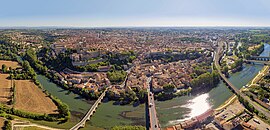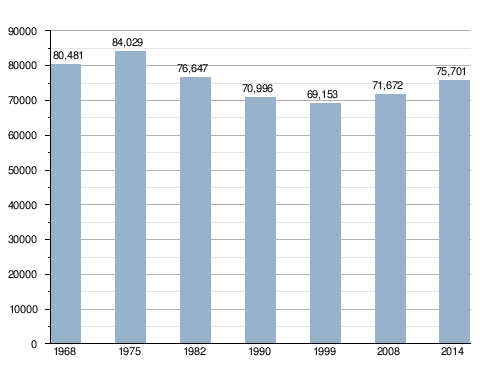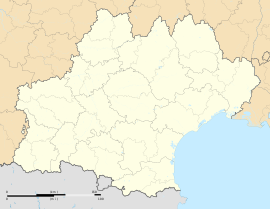Béziers (Occitan: Besièrs) is a commune in the Hérault département in the Occitanie region in southern France. It is a subprefecture of the department and also the capital of the arrondissement of the same name.
Béziers | |
|---|---|
Subprefecture and commune | |
 Aerial view of Béziers | |
| Coordinates: 43°20′51″N 3°13′08″E / 43.3476°N 3.219°E | |
| Country | France |
| Region | Occitanie |
| Department | Hérault |
| Arrondissement | Béziers |
| Canton | Béziers-1 Béziers-2 Béziers-3 |
| Intercommunality | Béziers Méditerranée |
| Government | |
| • Mayor (2014–2020) | Robert Ménard[1] |
| Area 1 | 95.48 km2 (36.87 sq mi) |
| Population (2014) | 75,701 |
| • Density | 790/km2 (2,100/sq mi) |
| Demonym | Biterrois |
| Time zone | UTC+01:00 (CET) |
| • Summer (DST) | UTC+02:00 (CEST) |
| INSEE/Postal code | 34032 /34500 |
| Elevation | 4–120 m (13–394 ft) (avg. 17 m or 56 ft) |
| Website | www.ville-beziers.fr |
| 1 French Land Register data, which excludes lakes, ponds, glaciers > 1 km2 (0.386 sq mi or 247 acres) and river estuaries. | |
Béziers is one of the oldest cities in France. Research shows that Béziers was built by Greeks in the 6th century BC.[2] Some archaeologists think that Béziers could be the oldest town of France, even before Marseille.[3]
History
changeThe site where is Béziers has been occupied since Neolithic times, before the arrival of Celts. Roman Betarra was on the road that linked Provence with Iberia. The Romans refounded the city as a new place for veterans in 36–35 BC and called it Colonia Julia Baeterrae Septimanorum. Stones from the Roman amphitheatre were used to construct the city wall during the 3rd century. The city was occupied by the Moors between 720 and 752.
Béziers was a Languedoc stronghold of Catharism, which the Catholic Church condemned as heretical and which Catholic forces exterminated in the Albigensian Crusade.
Béziers was the first place to be attacked. The crusaders got to the town on 21 July 1209 and burned the cathedral of Saint Nazaire. A few parts of the Romanesque cathedral survived, and repairs started in 1215. The restoration, along with that of the rest of the city, continued until the 15th century.
After the Louis Napoléon's coup d'état in 1851, troops killed protesters in Béziers. Others were condemned to death or taken to the Guiana.
Geography
changeThe city is in the southeastern of the department, in the plain of Hérault (the plaine héraultoise). It is on a small cliff on the eastern side of the Orb river, a tributary of the Hérault river.
The commune has an area of 95.48 km2 (36.87 sq mi), the largest commune in the department, and is at an altitude of about 4–120 m (13–394 ft) above sea level. Béziers is at 75 km (47 mi) to the southeast of the city of Montpellier and at 12 km (7.5 mi) from the Mediterranean Sea.
The commune of Béziers is surrounded by the communes Boujan-sur-Libron, Maraussan, Lignan-sur-Orb, Villeneuve-lès-Béziers, Corneilhan, Sauvian, Colombiers, Cers, Montady, Maureilhan, Bassan and Vendres.
Climate
changeThe climate of Béziers, in the Köppen climate classification, is Csa - Mediterranean climate with hot summers.
Population
changeThe inhabitants of Béziers are known, in French, as Biterrois (women: Biterroises),[4] from Baeterrae, the Latin name of the city.
With a population of 75,701,[5] Béziers has a population density of 793 inhabitants/km2.
Evolution of the population in Béziers

Béziers forms with other four communes the urban area of Béziers with a population of 89,243 inhabitants (2013) and an area of 135.6 km2 (52.4 sq mi).[6] This urban area is the centre of the metropolitan area of Béziers, formed by 40 communes with a population of 168,960 inhabitants (2013) and an area of 708.4 km2 (273.5 sq mi).[7]
Administration
changeBéziers is a subprefecture of the Hérault department, the capital of the arrondissement of Béziers and the administrative centre (French: chef-lieu) of three cantons: Béziers-1, Béziers-2 and Béziers-3.
It is part of the intercommunality Béziers Méditerranée (French: Communauté d'agglomération Béziers Méditerranée).
Sister cities
changeBéziers is twinned with:
- Chiclana de la Frontera, Cádiz, Andalusia, Spain, since 1993
- Heilbronn, Baden-Württemberg, Germany, since 1965
- Stavropol, Stavropol Krai, Russia, since 1982
- Stockport, Greater Manchester, United Kingdom, since 1972
Sites of interest
change- Saint-Nazaire Cathedral (Cathédrale Saint-Nazaire), from the 14th century.
- Pont Vieux, a stone bridge over the Orb, from the Middle Ages.
- Canal du Midi, a canal (17th century).
Gallery
changeRelated pages
changeReferences
change- ↑ "Annuaire des élus" (in French). Ville de Béziers. Archived from the original on 8 February 2017. Retrieved 1 March 2017.
- ↑ Ludovic Trabuchet. "Des révélations sur le passé grec de Béziers" (in French). Midilibre.fr. Retrieved 2 March 2017.
- ↑ Baudoin Eschapasse. "La plus vieille ville de France ?" (in French). lepoint.fr. Archived from the original on 2016-11-18. Retrieved 2 March 2017.
- ↑ "Hérault" (in French). habitants.fr. Retrieved 2 March 2017.
- ↑ "Régions, départements, arrondissements, cantons et communes" (PDF). Populations légales 2014 (in French). Institut national de la statistique et des études économiques - INSEE. Retrieved 1 March 2017.
- ↑ "Unité urbaine de Béziers (34501)". Comparateur de territoire (in French). Institut national de la statistique et des études économiques - INSEE. Retrieved 2 March 2017.
- ↑ "Aire urbaine de Béziers (053)". Comparateur de territoire (in French). Institut national de la statistique et des études économiques - INSEE. Retrieved 2 March 2017.
Other websites
change- Ville de Béziers website (in French)
- Communauté d'agglomération Béziers Méditerranée website (in French)
- Béziers in Méditerranée Tourism Office Archived 2017-02-26 at the Wayback Machine



